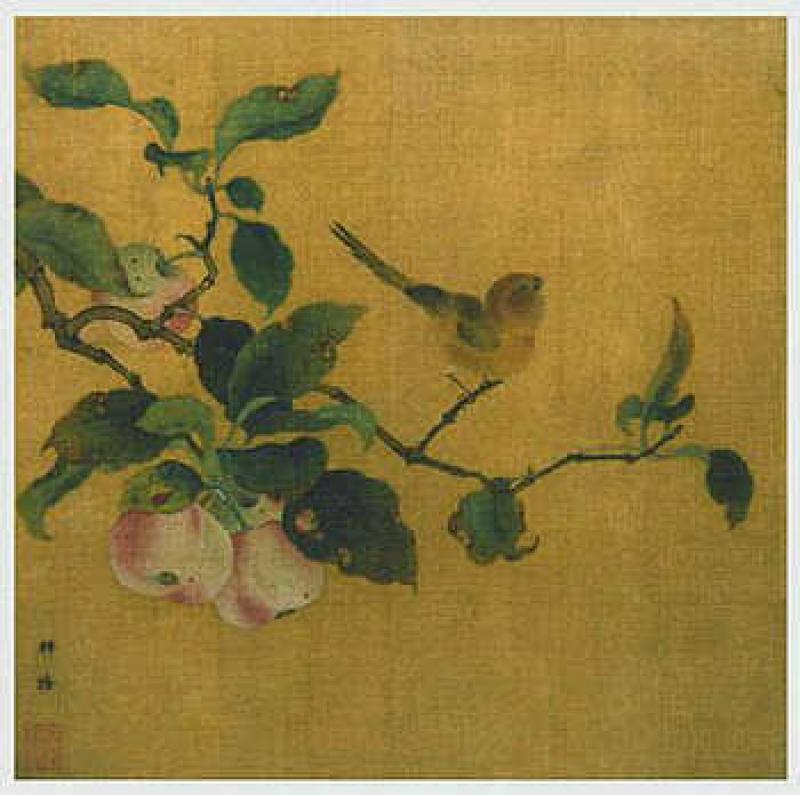Chinese Ancient Painting
By: No Author Indicated

Chinese Ancient Painting
Ancient Chinese paintings can be traced back to as early as 5,000 to 6,000 years ago, when people began to use minerals to draw simple pictures resembling animals, plants, and even human beings on rocks and produce drawings of amazing designs and decorations on the surface of potteries and later bronze containers. However, only a few of the works have survived over time. The earliest drawings that have been preserved till today were produced on paper and silk, which were burial articles with a history of over 2,000 years.

By Lu Ji, Ming Dynasty
As far as the subject is concerned, Chinese paintings fall into several categories, such as figure paintings, landscapes, and flower-and-bird paintings. European paintings, introduced into China in 17th century, were called "Western paintings," and the traditional local works, "the Chinese paintings."
As the representative of Eastern paintings, Chinese paintings greatly differ from the Western counterpart in terms of contents, forms, and styles. The following will give you a more vivid picture of the exotic Chinese paintings.
Colored Painting ( gongbi ) and Water-Ink Painting ( xieyi )
In terms of drawing skills, Chinese paintings can be categorized into two styles: colored paintings and water-ink paintings, with the former dominant before the 12th century by professional or craftsman painters, and the latter in and after the 12th century by literati painters.

By Xu Wei, Ming Dynasty
Also known as "fine-stroke" paintings, colored paintings feature close attention to details and fine brushwork. Thanks to the mineral-made dyes, the original colors can be fully maintained and the paintings will not fade away as time goes by. Colored paintings, which manifest in themselves unparalleled sublime air, were widely welcomed among the painters serving in royal courts.
On the contrary, water-ink paintings, also called "thick-stroke" paintings, are supposed to convey spiritual resonance with strokes as simple as possible, instead of attaching much importance to the realistic subjects.
Exaggerated forms, such as generalization and hyperbole as well as rich imagination, are employed in painting to display painters' feelings. Therefore, it is relatively difficult to make a copy of a water-ink painting.

By Su Hanchen, Song Dynasty
Anyway, there is no absolute line between the two schools. No matter which school they belonged to, painters could and did compromise a little and learn from each other, giving rise to a mixed style including elements from both.
A perfect integration of poetry, calligraphy, painting and seal engraving
Traditional Chinese paintings perfectly integrate poetry, calligraphy, painting, and seal engraving, all of which are necessary components. As Chinese is an ideographic language system, most of the Chinese characters in ancient times were produced with concise strokes according to the shapes or meanings of the signified, which naturally generated an artistic form of calligraphy closely connected with painting.
Chinese painters, in particular literati painters, would unconsciously draw with the styles of calligraphy. Writing poems became an established way to express their feelings during the process of drawing. In the end, according to the tradition of Chinese literati, red seals with their names engraved were used to sign their works, a tradition that continues to this day.

Actually, Chinese paintings clearly reveal that Chinese think in a holistic way. In other words, before drawing, painters must have an overall planning concerning the content of poems, the style of calligraphy, and the place where the works should be signed. The criterion of "Painting in poetry and poetry in painting" for excellent works was originally set by Sushi (1036-1101), the well-known painter and litterateur in the Northern Song Dynasty (960-1127). Other painters later held this idea in high esteem.
An obvious distinction between Chinese and European paintings lies in the fact that a piece of blank space is always reserved in Chinese paintings for clouds over mountains, fog haunting above rivers, light circles reflected from the sun or the moon, or nothing at all. Some argue that the "blankness" in Chinese paintings is the most appropriate vehicle to convey the uncertainty and ambiguity featured in Chinese poems.
Figure paintings, landscapes and flower-and-bird paintings
By Zhao Mengfu, Yuan Dynasty
Ample evidences can be found in fine-art archeology that paintings with people as the subject turned out to be the earliest one among all the categories of Chinese paintings and used to enjoy prosperous development. Dating back to the primitive age, ancestors drew pictures of human beings and animals on walls and rocks with white stalks, red bauxite, or charcoal.
However, figure paintings didn't get fully developed until 1,500 years ago, when Gu Dangzhi (348-409), the famous painter and art theorist, asserted that more attention should be paid not only to the external shapes of figures, but also the internal quality. Hereafter, this argument was accepted by artists and critics and taken as an established rule guiding the future production and comments of similar works.
As the most important and most influential category among Chinese paintings, the landscape paintings, which came into being much later and developed quickly in the Tang Dynasty(618-907), usually take images of natural scenery, such as mountains or rivers, as the subjects. Over the long history of paintings in ancient China, the largest portion of painters specialized in landscapes.
Landscape painting could reach its heyday and maintain its dominant role in Chinese paintings because of its deep root in Chinese traditional culture. Chinese philosophers in ancient times believed in the "unity of human beings and heaven," which means that human beings can feel nature and therefore should be in a harmonious relationship with it.
By Ren Bonian, Qing Dynasty
Having widely accepted this argument, which is different from the Western one that nature should be conquered, Chinese painters tended to integrate their feelings and dreams into the natural scenery they were producing, which meanwhile arouses aspiration and imagination from readers.
With flowers and grass, bamboos and rocks, birds and beasts, and worms and fish as the major subjects, flower-and-bird paintings are usually viewed and admired by viewers. The most frequently seen pictures feature a combination of flowers and birds, hence the flower-and-bird name.
By Lin Chun, Song Dynasty
Originally designed for craftwork, flower-and-bird painting eventually established itself as an independent school in the Tang Dynasty. What's more, considered sublime and elegant by literati in ancient China, the so-called "four gentlemen" including plum, orchid, bamboo, and chrysanthemum (mei, lan, zhu, ju) are the most welcomed subjects in Chinese flower-and-bird paintings.
.
.BUZZ NOTE: Political comments are off topic and will be deleted.







A pleasant and interesting lesson in the history of Chinese art.
Beautiful works of art and very interesting information. Thanks much for posting this.
Very beautiful artwork, Buzz. Thank you for sharing it with us.
Because of its generally two-dimensional feel, I've always thought of these works as "decorative"; this isn't a criticism, merely a response from someone who gravitates to more representational, literal imagery.
Nevertheless, articles like this make the Fine Arts Group something special. It's too bad there aren't more.
Yeah, can make nice wallpaper. Are you intending to rename the group again, this time to the 'Fine Arts Group? As for more, I will try to post another article on the group each week. I know another member intends to post an article soon as well.
Meant to say Creative Arts Group … gettin' old.
LOL. So am I.
Nice.
In case I forget, someone please post a link to this article in the Three-Day Weekend article on Friday.
Love it.